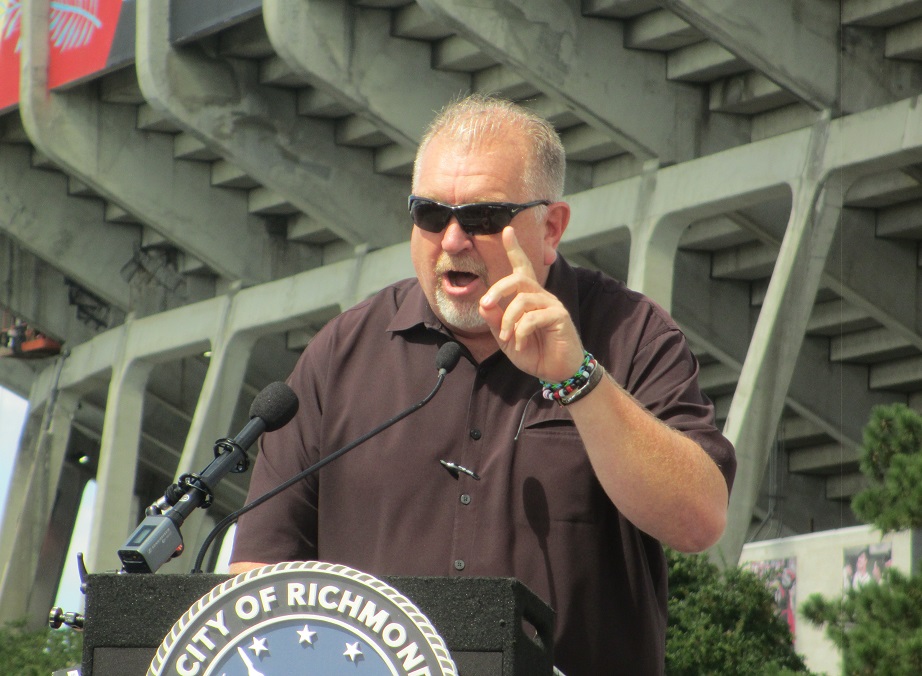
Flying Squirrels COO Todd “Parney” Parnell at the development team announcement for the Diamond District project earlier this month. (BizSense file photos)
At long last, more than a decade after they swooped into town with promises of a new ballpark, the Richmond Flying Squirrels are getting a new place to play ball.
Now, they just need to design it.
The City Council’s unexpectedly unanimous approval Monday of the Diamond District project that starts with a new stadium sets the stage for design work to get going in earnest, ahead of an ambitious construction schedule that developers have said must start by next spring in order for the ballpark to be delivered in time for the 2025 season.
That’s the deadline that Major League Baseball has set for all pro baseball venues to comply with new facilities standards, including The Diamond, a 37-year-old facility that has been deemed functionally obsolete and unfeasible for renovation.
Wasting no time, the city’s development partner, RVA Diamond Partners, is holding initial design meetings this week with staff of both the Flying Squirrels and VCU Athletics, whose Division I baseball team shares the minor-league ballclub’s facilities several months out of the year.
Having waited for this since arriving in Richmond in 2009, Flying Squirrels President Lou DiBella and COO Todd “Parney” Parnell said they’re chomping at the bit to get the process started.
In an interview with BizSense, DiBella said, “We’ve done the best we could under difficult circumstances for 14 years. You have no idea how much fun it’s going to be for Parney, everyone who works for me, and myself to watch what we do work in a place designed for it to work.”
Added Parnell: “We’ve been fighting a sword fight with a butter knife (at The Diamond). We’re really excited about having a ballpark that exemplifies what we do show-wise. It’s going to be night and day.”
360-degree experience
So, what do they want in their stadium of dreams? As Parnell put it: “Experience, experience, experience.”
“It’s all about the different interactive experiences that people can have every 30 feet, every 50 feet, every 75 feet,” Parnell said. “Whether it’s the club space, whether it’s the dugout suite, whether it’s the all-important 360-degree experience where you walk in right field and do something, you walk in center field and do something.”
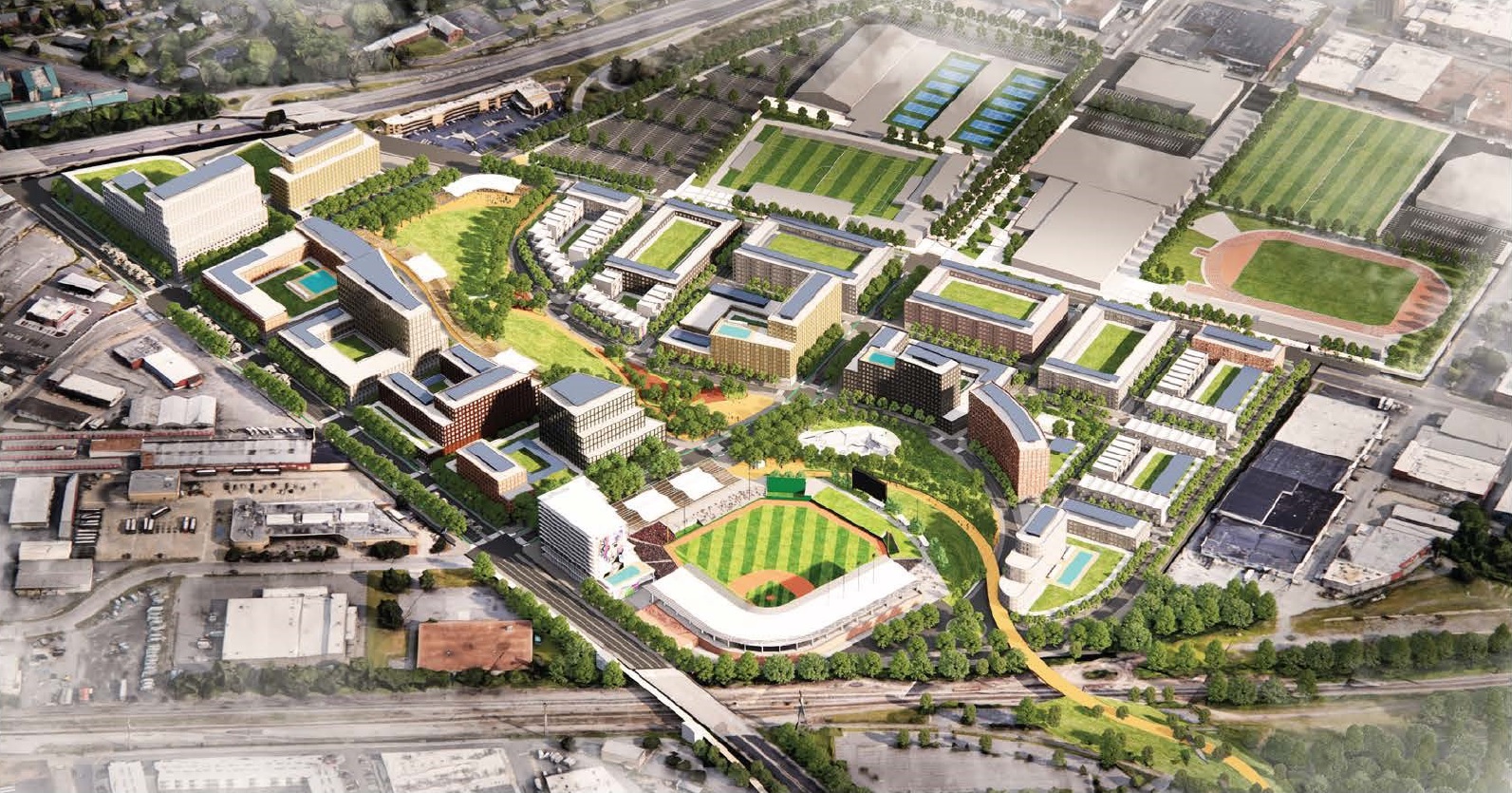
A conceptual rendering of the Diamond District development shows the new stadium with wraparound concourse. (Image courtesy of city documents)
To achieve that 360-degree experience, the stadium’s design is expected to feature a wraparound concourse encircling the field with various seating and standing areas providing views from all angles.
Where The Diamond has stadium seats and private suites, the new ballpark is being designed with a greater variety of viewing options, including standing areas with drink rails, field-level “dugout seats,” picnic areas and a berm with a covered party deck.
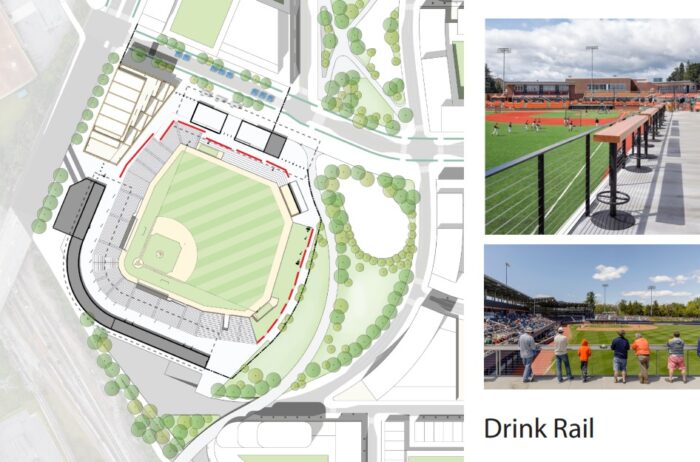
The wraparound concourse would enclose the field with a variety of seating and viewing areas. (Image courtesy of RVA Diamond Partners)
Jason Guillot, a principal with Thalhimer Realty Partners who’s the local lead for RVA Diamond Partners, said the 360-degree design approach has become standard and somewhat expected for new ballparks today.
“The idea with the new concourse is that no matter where you are walking around, you can keep up with the game,” Guillot said. “It’s especially helpful with families and kids who can’t sit still in a seat for nine innings.”
Noting entertainment concepts that have popped up in recent years that involve more than just eating or drinking, Guillot said, “People now, they want to be active. Same thing at a ballpark. You’re there of course to watch baseball, but you want to be able to move and to be social. That’s where everything is headed.”
Added Parnell: “The way people recreate and the way people watch minor league baseball games in 2022 is vastly different than it was in 1985 (when The Diamond was built). Back in those days, my dad took me to a game and we sat there and had a hot dog and a soda and watched the game. Now, it’s all about interaction.”
Required vs. desired
Beyond improvements required by MLB – which found The Diamond out of compliance for a lack of dressing rooms for female staff, lack of commissaries and dining areas, insufficient clubhouse, training and weight room space, and a lack of enclosed pitching and hitting tunnels – Parnell and DiBella listed some specifics they’d like to see with the new stadium.
Primary among them is additional concessions to reduce wait times for fans buying food and beverages. Parnell and DiBella acknowledged existing wait times at The Diamond are too long and said their goal for the new venue is four- to five-minute waits.
Also desired are better-ventilated seats to help keep fans cooler in the summer months. They said ticket affordability and general accessibility are priorities, as is the ballpark’s conformity with the surrounding area and larger Diamond District development.
“We want a ballpark that looks like it belongs in the Diamond District and one that we can be proud of and creates the best experiences for fans,” DiBella said. “We’re not sitting there demanding crazy bells and whistles; we want a home that works best for us and works best for the people we care about, meaning our neighbors and our fans.”
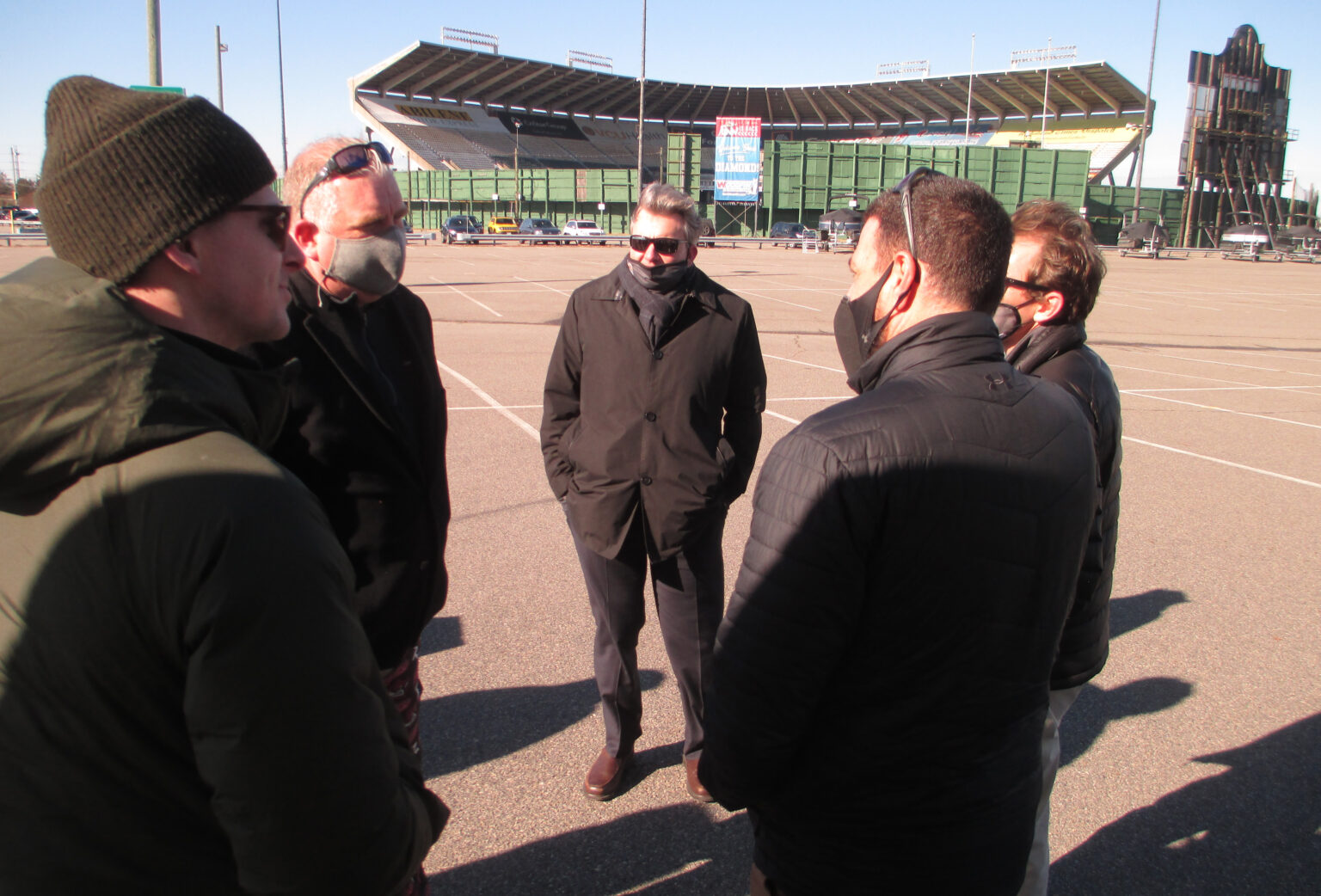
Todd Parnell, second from left, and VCU Athletics’ Ed McLaughlin, center, met with prospective developers at a Diamond District site visit in January. (BizSense file photo)
Guillot said other amenities being considered for the ballpark include a Richmond sports hall of fame, a flex area for games and programming, more social spaces, a playground for kids, a walk-in team store, a Richmond 34 memorial, and loge seating with boxes. He said the number of suites would increase from 16 to as many as 24 with larger outdoor lounge areas, and club seating would be expanded with private spaces.
In addition to meeting MLB’s standards, the new 10,000-capacity stadium is also required to meet development criteria laid out in the approved term sheet between the city and RVA Diamond Partners.
The term sheet, to be followed by more definitive agreements, calls for the stadium to be designed and built to the U.S. Green Building Council’s LEED Silver certification standards, and that lighting installed at The Diamond this year be reused in the new stadium, among other design requirements.
To be built south of The Diamond to allow for continued play during construction, the new stadium is expected to fill 7 to 10 acres and cost about $80 million, according to a ballpark feasibility analysis included in the city’s solicitation for the Diamond District project.
The new stadium would seat about 8,000 with space for 2,000 standing-room patrons. The Diamond currently seats about 9,500, with attendance for Flying Squirrels games averaging over 6,000.
Despite The Diamond’s challenges, according to the analysis, the Flying Squirrels have achieved a total annual attendance of 400,000, ranking third-highest of any Double-A ballclub and 23rd among all MiLB teams in 2019.
‘A home of our own’
Also involved in the design discussion is VCU Athletics Director Ed McLaughlin, who said the new stadium would provide the Rams baseball team with “a home of our own.”
“We don’t have our own clubhouse, we don’t have our own lounge for the players. We don’t have any of those amenities that Division I baseball teams have, especially those who are winning like we are and having such success,” McLaughlin said. “It’s through no fault of (the Squirrels). They’re great partners. The infrastructure at The Diamond is just terrible and horribly outdated.”
McLaughlin said desired features for VCU include not only a clubhouse and lounge, but also space for coaches to meet one-on-one with players and batting cages specific to the team. Currently, the team practices at VCU’s Baseball Performance Center, a $2 million facility it opened in 2019 below the Bowe Street parking deck.
“We’ve made the best of it what we can, but certainly as it goes forward … even just a place for our team to be over there and take recruits and things like that, that would be a huge lift for us,” McLaughlin said.
Guillot said they’re keeping VCU’s needs in mind with the design.
“We’re thinking a lot about VCU,” he said. “One of the biggest challenges with VCU in the current stadium is that when the Rams show up, they don’t feel as if they have identity and ownership in the ballpark.”
Guillot said ideas to give ownership to each team include projecting their respective logos onto walls when each is playing.
“The goal is for them to feel like this is a home game in Ram Nation, more than ever before,” he said.
Team effort
Working with the Squirrels and VCU to achieve the desired stadium are DLR Group and JMI Sports, RVA Diamond Partners’ stadium designer and development consultant, respectively. DLR’s 22 minor-league ballpark credits include Fluor Field stadium in Greenville, South Carolina, and Riverfront Stadium in Wichita, Kansas.
Also involved in the stadium design are New York-based Skidmore, Owings & Merrill Architects, the group’s master architect for the entire 67-acre Diamond District site, and landscape architect Nelson Byrd Woltz out of Charlottesville.
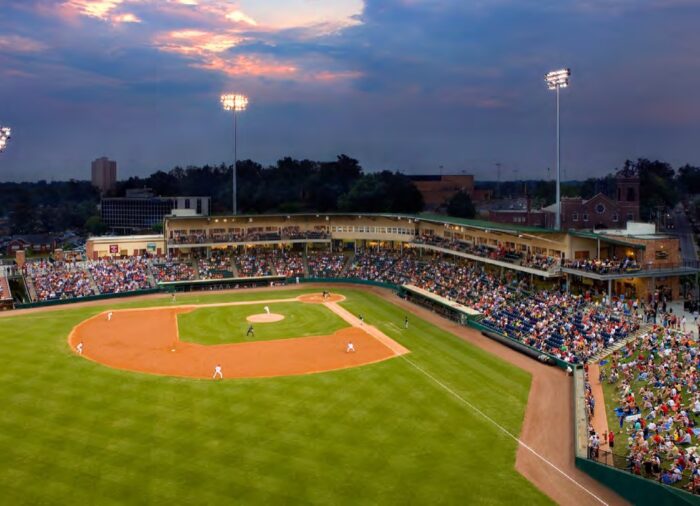
Fluor Field in Greensville, South Carolina, is among the 22 minor-league ballparks in DLR Group’s portfolio. (Image courtesy of RVA Diamond Partners)
Heading up the group along with Thalhimer Realty Partners are D.C.-based Republic Properties Corp., whose mixed-use projects there include Washington Harbour on the Georgetown waterfront, and Chicago-based investment bank Loop Capital.
DiBella and Parnell said discussions with the group over the course of its selection have assured them that the stadium will be a team effort.
“I am excited about the fact that Jason and his group seem to be really interested in what Lou and I and the Squirrels want,” Parnell said. “They know that we’re in this business and we’re well-respected in this business. They’re real estate developers, we’re baseball people, so I think they’re really looking for our ideas, which Lou and I and the other owners welcome.”
Parnell and DiBella pointed to the Charlotte Knights’ Truist Field and the Durham Bulls Athletic Park as existing stadiums they’d like to see as reference points for the new ballpark.
While those stadiums have rated well, Guillot said both are older than the standards being required by MLB.
He said two examples of new stadiums being actively designed and built to the standards are in Chattanooga and Knoxville, Tennessee. He added that a Minor League Baseball executive recently pointed to those projects as good examples of what should be built in Richmond.
“We’re really in new territory, in a sense,” Guillot said.
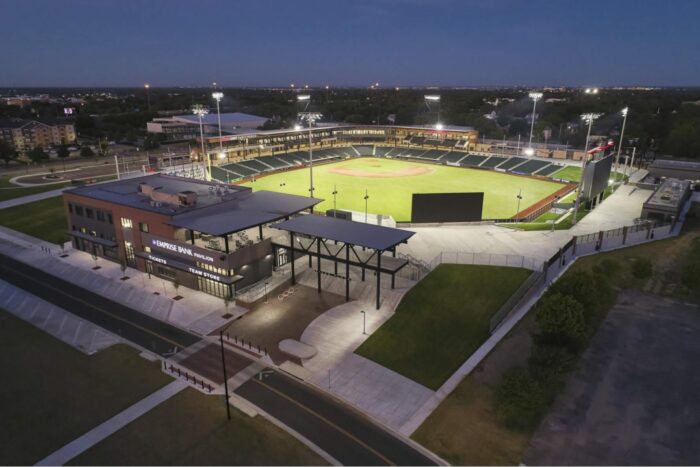
DLR Group’s ballparks include the 10,000-capacity Riverfront Stadium in Wichita, Kansas. (Image courtesy RVA Diamond Partners)
The Flying Squirrels – the Double-A affiliate of the San Francisco Giants – ended their 2022 season in Game 2 of the Eastern League playoffs on Saturday. It was their first playoff appearance in eight years.
A few evenings earlier, DiBella said he was hearing from Giants’ coaches about how much their players love coming up through Richmond, even with The Diamond’s challenges.
“They want to move up the ladder, but they want to be in Richmond,” DiBella said. “The players that are here, despite the fact we’re in an antiquated, almost 40-year-old stadium, rave about the experience here.”
He added, “Imagine the experience we’re going to be able to deliver in a beautiful ballpark designed for fun, designed to be fan-friendly, designed for people with disabilities and the elderly, designed to be accessible to everyone. It’s going to create a whole new opportunity for us to do what we do even better, and the people that come into that ballpark are going to leave with incredible memories.”

Flying Squirrels COO Todd “Parney” Parnell at the development team announcement for the Diamond District project earlier this month. (BizSense file photos)
At long last, more than a decade after they swooped into town with promises of a new ballpark, the Richmond Flying Squirrels are getting a new place to play ball.
Now, they just need to design it.
The City Council’s unexpectedly unanimous approval Monday of the Diamond District project that starts with a new stadium sets the stage for design work to get going in earnest, ahead of an ambitious construction schedule that developers have said must start by next spring in order for the ballpark to be delivered in time for the 2025 season.
That’s the deadline that Major League Baseball has set for all pro baseball venues to comply with new facilities standards, including The Diamond, a 37-year-old facility that has been deemed functionally obsolete and unfeasible for renovation.
Wasting no time, the city’s development partner, RVA Diamond Partners, is holding initial design meetings this week with staff of both the Flying Squirrels and VCU Athletics, whose Division I baseball team shares the minor-league ballclub’s facilities several months out of the year.
Having waited for this since arriving in Richmond in 2009, Flying Squirrels President Lou DiBella and COO Todd “Parney” Parnell said they’re chomping at the bit to get the process started.
In an interview with BizSense, DiBella said, “We’ve done the best we could under difficult circumstances for 14 years. You have no idea how much fun it’s going to be for Parney, everyone who works for me, and myself to watch what we do work in a place designed for it to work.”
Added Parnell: “We’ve been fighting a sword fight with a butter knife (at The Diamond). We’re really excited about having a ballpark that exemplifies what we do show-wise. It’s going to be night and day.”
360-degree experience
So, what do they want in their stadium of dreams? As Parnell put it: “Experience, experience, experience.”
“It’s all about the different interactive experiences that people can have every 30 feet, every 50 feet, every 75 feet,” Parnell said. “Whether it’s the club space, whether it’s the dugout suite, whether it’s the all-important 360-degree experience where you walk in right field and do something, you walk in center field and do something.”

A conceptual rendering of the Diamond District development shows the new stadium with wraparound concourse. (Image courtesy of city documents)
To achieve that 360-degree experience, the stadium’s design is expected to feature a wraparound concourse encircling the field with various seating and standing areas providing views from all angles.
Where The Diamond has stadium seats and private suites, the new ballpark is being designed with a greater variety of viewing options, including standing areas with drink rails, field-level “dugout seats,” picnic areas and a berm with a covered party deck.

The wraparound concourse would enclose the field with a variety of seating and viewing areas. (Image courtesy of RVA Diamond Partners)
Jason Guillot, a principal with Thalhimer Realty Partners who’s the local lead for RVA Diamond Partners, said the 360-degree design approach has become standard and somewhat expected for new ballparks today.
“The idea with the new concourse is that no matter where you are walking around, you can keep up with the game,” Guillot said. “It’s especially helpful with families and kids who can’t sit still in a seat for nine innings.”
Noting entertainment concepts that have popped up in recent years that involve more than just eating or drinking, Guillot said, “People now, they want to be active. Same thing at a ballpark. You’re there of course to watch baseball, but you want to be able to move and to be social. That’s where everything is headed.”
Added Parnell: “The way people recreate and the way people watch minor league baseball games in 2022 is vastly different than it was in 1985 (when The Diamond was built). Back in those days, my dad took me to a game and we sat there and had a hot dog and a soda and watched the game. Now, it’s all about interaction.”
Required vs. desired
Beyond improvements required by MLB – which found The Diamond out of compliance for a lack of dressing rooms for female staff, lack of commissaries and dining areas, insufficient clubhouse, training and weight room space, and a lack of enclosed pitching and hitting tunnels – Parnell and DiBella listed some specifics they’d like to see with the new stadium.
Primary among them is additional concessions to reduce wait times for fans buying food and beverages. Parnell and DiBella acknowledged existing wait times at The Diamond are too long and said their goal for the new venue is four- to five-minute waits.
Also desired are better-ventilated seats to help keep fans cooler in the summer months. They said ticket affordability and general accessibility are priorities, as is the ballpark’s conformity with the surrounding area and larger Diamond District development.
“We want a ballpark that looks like it belongs in the Diamond District and one that we can be proud of and creates the best experiences for fans,” DiBella said. “We’re not sitting there demanding crazy bells and whistles; we want a home that works best for us and works best for the people we care about, meaning our neighbors and our fans.”

Todd Parnell, second from left, and VCU Athletics’ Ed McLaughlin, center, met with prospective developers at a Diamond District site visit in January. (BizSense file photo)
Guillot said other amenities being considered for the ballpark include a Richmond sports hall of fame, a flex area for games and programming, more social spaces, a playground for kids, a walk-in team store, a Richmond 34 memorial, and loge seating with boxes. He said the number of suites would increase from 16 to as many as 24 with larger outdoor lounge areas, and club seating would be expanded with private spaces.
In addition to meeting MLB’s standards, the new 10,000-capacity stadium is also required to meet development criteria laid out in the approved term sheet between the city and RVA Diamond Partners.
The term sheet, to be followed by more definitive agreements, calls for the stadium to be designed and built to the U.S. Green Building Council’s LEED Silver certification standards, and that lighting installed at The Diamond this year be reused in the new stadium, among other design requirements.
To be built south of The Diamond to allow for continued play during construction, the new stadium is expected to fill 7 to 10 acres and cost about $80 million, according to a ballpark feasibility analysis included in the city’s solicitation for the Diamond District project.
The new stadium would seat about 8,000 with space for 2,000 standing-room patrons. The Diamond currently seats about 9,500, with attendance for Flying Squirrels games averaging over 6,000.
Despite The Diamond’s challenges, according to the analysis, the Flying Squirrels have achieved a total annual attendance of 400,000, ranking third-highest of any Double-A ballclub and 23rd among all MiLB teams in 2019.
‘A home of our own’
Also involved in the design discussion is VCU Athletics Director Ed McLaughlin, who said the new stadium would provide the Rams baseball team with “a home of our own.”
“We don’t have our own clubhouse, we don’t have our own lounge for the players. We don’t have any of those amenities that Division I baseball teams have, especially those who are winning like we are and having such success,” McLaughlin said. “It’s through no fault of (the Squirrels). They’re great partners. The infrastructure at The Diamond is just terrible and horribly outdated.”
McLaughlin said desired features for VCU include not only a clubhouse and lounge, but also space for coaches to meet one-on-one with players and batting cages specific to the team. Currently, the team practices at VCU’s Baseball Performance Center, a $2 million facility it opened in 2019 below the Bowe Street parking deck.
“We’ve made the best of it what we can, but certainly as it goes forward … even just a place for our team to be over there and take recruits and things like that, that would be a huge lift for us,” McLaughlin said.
Guillot said they’re keeping VCU’s needs in mind with the design.
“We’re thinking a lot about VCU,” he said. “One of the biggest challenges with VCU in the current stadium is that when the Rams show up, they don’t feel as if they have identity and ownership in the ballpark.”
Guillot said ideas to give ownership to each team include projecting their respective logos onto walls when each is playing.
“The goal is for them to feel like this is a home game in Ram Nation, more than ever before,” he said.
Team effort
Working with the Squirrels and VCU to achieve the desired stadium are DLR Group and JMI Sports, RVA Diamond Partners’ stadium designer and development consultant, respectively. DLR’s 22 minor-league ballpark credits include Fluor Field stadium in Greenville, South Carolina, and Riverfront Stadium in Wichita, Kansas.
Also involved in the stadium design are New York-based Skidmore, Owings & Merrill Architects, the group’s master architect for the entire 67-acre Diamond District site, and landscape architect Nelson Byrd Woltz out of Charlottesville.

Fluor Field in Greensville, South Carolina, is among the 22 minor-league ballparks in DLR Group’s portfolio. (Image courtesy of RVA Diamond Partners)
Heading up the group along with Thalhimer Realty Partners are D.C.-based Republic Properties Corp., whose mixed-use projects there include Washington Harbour on the Georgetown waterfront, and Chicago-based investment bank Loop Capital.
DiBella and Parnell said discussions with the group over the course of its selection have assured them that the stadium will be a team effort.
“I am excited about the fact that Jason and his group seem to be really interested in what Lou and I and the Squirrels want,” Parnell said. “They know that we’re in this business and we’re well-respected in this business. They’re real estate developers, we’re baseball people, so I think they’re really looking for our ideas, which Lou and I and the other owners welcome.”
Parnell and DiBella pointed to the Charlotte Knights’ Truist Field and the Durham Bulls Athletic Park as existing stadiums they’d like to see as reference points for the new ballpark.
While those stadiums have rated well, Guillot said both are older than the standards being required by MLB.
He said two examples of new stadiums being actively designed and built to the standards are in Chattanooga and Knoxville, Tennessee. He added that a Minor League Baseball executive recently pointed to those projects as good examples of what should be built in Richmond.
“We’re really in new territory, in a sense,” Guillot said.

DLR Group’s ballparks include the 10,000-capacity Riverfront Stadium in Wichita, Kansas. (Image courtesy RVA Diamond Partners)
The Flying Squirrels – the Double-A affiliate of the San Francisco Giants – ended their 2022 season in Game 2 of the Eastern League playoffs on Saturday. It was their first playoff appearance in eight years.
A few evenings earlier, DiBella said he was hearing from Giants’ coaches about how much their players love coming up through Richmond, even with The Diamond’s challenges.
“They want to move up the ladder, but they want to be in Richmond,” DiBella said. “The players that are here, despite the fact we’re in an antiquated, almost 40-year-old stadium, rave about the experience here.”
He added, “Imagine the experience we’re going to be able to deliver in a beautiful ballpark designed for fun, designed to be fan-friendly, designed for people with disabilities and the elderly, designed to be accessible to everyone. It’s going to create a whole new opportunity for us to do what we do even better, and the people that come into that ballpark are going to leave with incredible memories.”

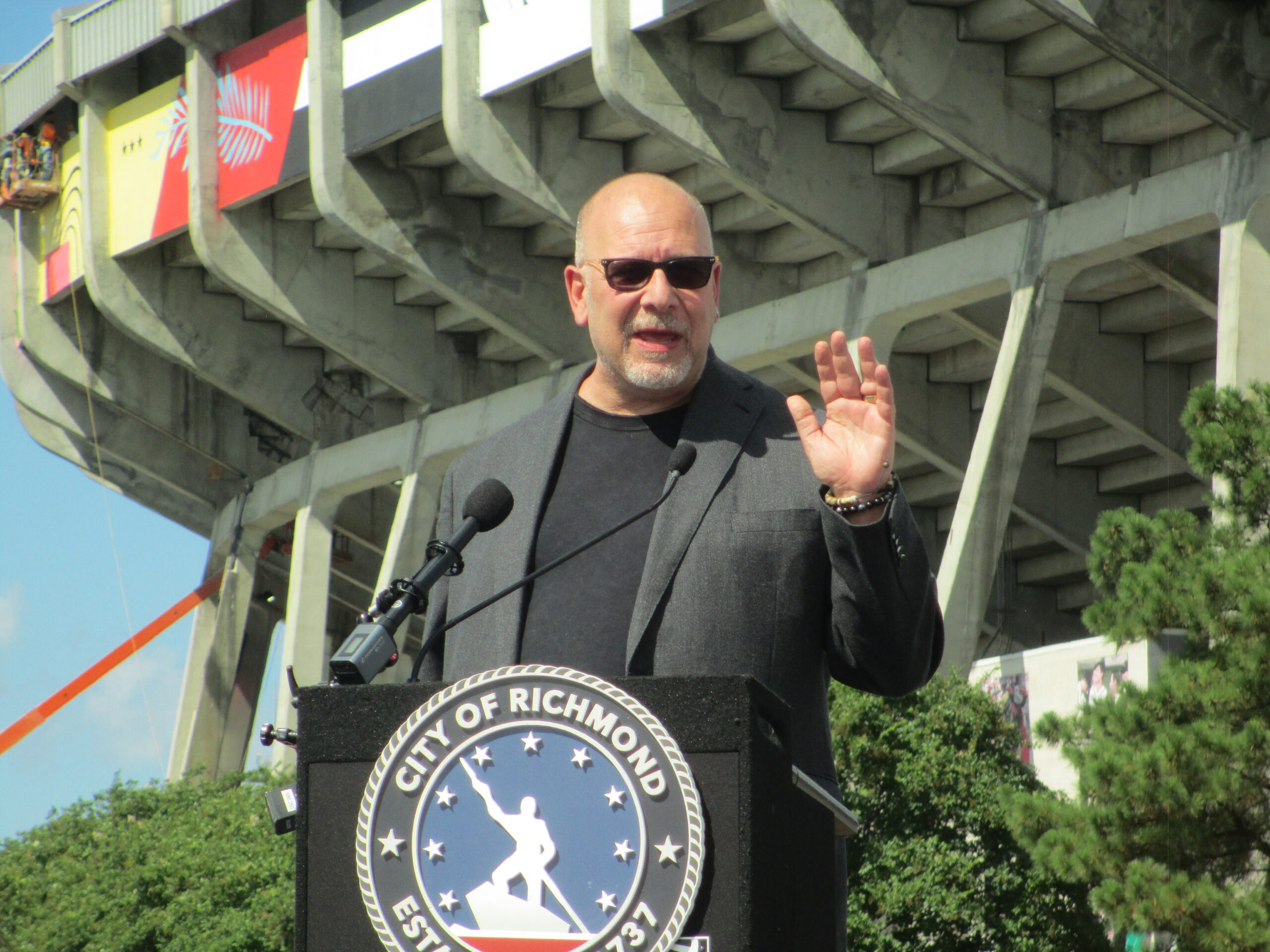
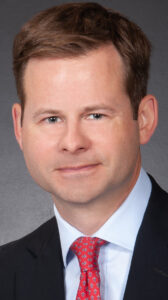
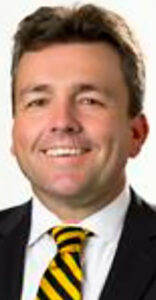


Its wonderful that they’ve hung on and waited for the day they’ll have this ballpark. There’s so much to look forward to! The challenge that the Diamond District faces is the godawful access from I-95 and how they’ll get all those suburban family vehicles in and out of the garages that will encircle the ballpark that will also service more than 1,000 new residences. Its been done elsewhere though and I’m sure they’ll find a way!
The Diamond was a dump from the first day it opened, it is nice to see some genuine thought and planning going into it this time. Of course now it will be like all the other ball parks, home of $20 beers and $18 nachos, $25 to park your car, and taking the family to the game will be a $200 excursion.
All Council did was vote “to select RVA Diamond Partners LLC as the developer of the Diamond District and express the Council’s support for certain proposed minimum business terms and conditions in relation to the development of the Diamond District.” This was no legal contract, no development deal. It simple says the RFP process is done and we want to officially negotiate with this LLC. The devil (and delays) will be in the financial details coming forward not the design.
Maybe it was mentioned in a different article. But what level of financial contributions are the Squirrels ownership group and VCU contributing to this stadium?
Would be nice to have that information balancing out the clubs expectations for amenities…
I read that both Squirrels and VCU will pay rent (one figure mentioned was $1M Squirrels annual rent), which presumably will go toward annual payments for the stadium construction bonds.
I really hope they keep come emphasis on seats around the infield, even in a small upper deck area, and not just fill out less-than-fun “lower deck” seats massed out beyond the infield dirt. Those are the worst seats in baseball – Upper decks around home plate is far, far superior. I’m not a fan at all of the current “model” for new minor league parks – all for wrap-around concourses, but just make sure to keep the majority of the seating between the bases, please!
The rendering of Riverfront Stadium in Wichita Kansas has too many seats exposed to the sun. The orientation of the ballpark should be similar to the Diamond. We have more heat and humidity here and shade is a must for fan comfort. The design should also take into account the angle of the sun for the outfielders in particular.
per Google: “Major League Baseball Rule 1.04 states: “It is desirable that the line from home base through the pitchers plate to second base shall run East Northeast.” So this is pretty much “in line” (pun intended!)
“Parnell and DiBella pointed to the Charlotte Knights’ Truist Field and the Durham Bulls Athletic Park as existing stadiums they’d like to see as reference points for the new ballpark.”
Both of those parks are Triple-A parks that hold over 10,000 people. The Flying Squirrels are a Double-A team that averaged around 6,000 people since they have been here. Is there a reason those parks are being used as reference points? Does Richmond have plans on a huge increase in attendance?
No, but minor league affiliations don’t last forever and its long been rumored that the Nats would one day like to make Richmond their AAA affiliate. Regardless of that coming to fruition, the goal is likely to have a stadium that can meet AAA requirements if things fell into place.
Hope maybe one of the fortune 500 companies that are headquartered here or have a large employee base will take the naming rights. Here is an Idea Lego Stadium and add a Lego innovation center/museum on to it. Just a Thought
Perhaps CoStar will step into the opportunity. They will soon be one of City’s biggest employers and owner occupy its tallest building.
They have a long way to being one of the City’s biggest employers with VCU Health System at 13,500 Capital One around 13,000 and HCA at about 11,000. I think after they are at about 1,200 now and adding 2,000 to 4,000 would put them around 5,000 which would put them at #7 behind Dominion Energy and In front of Truist and Amazon. But knowing Andy Florence he would be all for it.
in keeping with our “You’re Very Richmond” tendencies, I’m betting the new stadium will still be referred to by locals as The Diamond for years, despite a new structure, location and name!
If you are very very Richmond, then the name will be Parker Field.